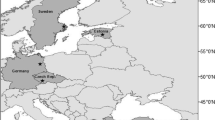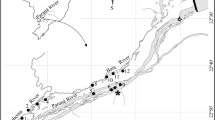Abstract
The stress–size hypothesis predicts that smaller organisms will be less sensitive to stress. Consequently, climate warming is expected to favour smaller taxa from lower trophic levels and smaller individuals within populations. To test these hypotheses, we surveyed zooplankton communities in 20 boreal lakes in Killarney Provincial Park, Canada during 2005 (an anomalously warm summer) and 2006 (a normal summer). Higher trophic levels had larger responses to warm temperatures supporting the stress–size hypothesis; however, rather than imposing negative effects, higher density and biomass were observed under warmer temperatures. As a result, larger taxa from higher trophic levels were disproportionately favoured with warming, precluding an expected shift towards smaller species. Proportionately greater increases in metabolic rates of larger organisms or altered biotic interactions (e.g. predation and competition) are possible explanations for shifts in biomass distribution. Warmer temperatures also favoured smaller individuals of the two most common species, in agreement with the stress–size hypothesis. Despite this, these populations had higher biomass in the warm summer. Therefore, reduced adult survivorship may have triggered these species to invest in reproduction over growth. Hence, warmer epilimnions, higher zooplankton biomass and smaller individuals within zooplankton populations may function as sensitive indicators of climate warming in boreal lakes.




Similar content being viewed by others
References
Adrian, R., C. M. O’Reilly, H. Zagarese, S. B. Baines, D. O. Hessen, W. Keller, D. M. Livingstone, R. Sommaruga, D. Straile, E. Van Donk, G. A. Weyhenmeyer & M. Winder, 2009. Lakes as sentinels of climate change. Limnology and Oceanography 54: 2283–2297.
Anneville, O., J. C. Molinero, S. Souissi & D. Gerdeaux, 2010. Seasonal, interannual variability of cladoceran communities in two peri-alpine lakes: uncoupled response to the 2003 heat wave. Journal of Plankton Research 32: 913–925.
Arnott, S. E., N. Yan, W. Keller & K. Nicholls, 2001. The influence of drought-induced acidification on the recovery of plankton in Swan Lake (Canada). Ecological Applications 11: 747–763.
Barbiero, R. P. & C. M. McNair, 1996. The dynamics of vertical chlorophyll distribution in an oligomesotrophic lake. Journal of Plankton Research 18: 225–237.
Barnett, A. J., K. Finlay & B. E. Beisner, 2007. Functional diversity of crustacean zooplankton communities: towards a trait-based classification. Freshwater Biology 52: 796–813.
Barton, B. T., A. P. Beckerman & O. J. Schmitz, 2009. Climate warming strengthens indirect interactions in an old-field food web. Ecology 90: 2346–2351.
Brown, J. H., J. F. Gillooly, A. P. Allen, V. M. Savage & G. B. West, 2004. Toward a metabolic theory of ecology. Ecology 85: 1771–1789.
Burns, C. W., 1969. Relation between filtering rate, temperature, and body size in four species of Daphnia. Limnology and Oceanography 14: 693.
Carter, J. C. H., M. J. Dadswell, J. C. Roff & W. G. Sprules, 1980. Distribution and zoogeography of planktonic crustaceans and dipterans in glaciated eastern North America. Canadian Journal of Zoology 58: 1355–1387.
Cattaneo, A., A. Asioli, P. Comoli & M. Manca, 1998. Organisms’ response in a chronically polluted lake supports hypothesized link between stress and size. Limnology and Oceanography 43: 1938–1943.
Chen, C. Y. & C. L. Folt, 2002. Ecophysiological responses to warming events by two sympatric zooplankton species. Journal of Plankton Research 24: 579–589.
Culver, D. A., M. M. Boucherle, D. J. Bean & J. W. Fletcher, 1985. Biomass of freshwater crustacean zooplankton from length–weight regressions. Canadian Journal of Fisheries and Aquatic Sciences 42: 1380–1390.
Dai, A., K. E. Trenberth & T. T. Qian, 2004. A global dataset of Palmer Drought Severity Index for 1870–2002: relationship with soil moisture and effects of surface warming. Journal of Hydrometeorology 5: 1117–1130.
Daufresne, M., K. Lengfellner & U. Sommer, 2009. Global warming benefits the small in aquatic ecosystems. Proceedings of the National Academy of Sciences of the United States of America 106: 12788–12793.
Francis, T. B., D. E. Schindler, G. W. Holtgrieve, E. R. Larson, M. D. Scheuerell, B. X. Semmens & E. J. Ward, 2011. Habitat structure determines resource use by zooplankton in temperate lakes. Ecology Letters 14: 364–372.
Gerten, D. & R. Adrian, 2000. Climate-driven changes in spring plankton dynamics and the sensitivity of shallow polymictic lakes to the North Atlantic Oscillation. Limnology and Oceanography 45: 1058–1066.
Gilman, S. E., M. C. Urban, J. Tewksbury, G. W. Gilchrist & R. D. Holt, 2010. A framework for community interactions under climate change. Trends in Ecology & Evolution 25: 325–331.
Gunn, J. M., E. Snucins, N. D. Yan & M. T. Arts, 2001. Use of water clarity to monitor the effects of climate change and other stressors on oligotrophic lakes. Environmental Monitoring and Assessment 67: 69–88.
Hampton, S. E., L. R. Izmest’eva, M. V. Moore, S. L. Katz, B. Dennis & E. A. Silow, 2008. Sixty years of environmental change in the world’s largest freshwater lake – Lake Baikal, Siberia. Global Change Biology 14: 1947–1958.
Herzig, A., 1983. The ecological significance of the relationship between temperature and duration of embryonic development in plankton freshwater copepod. Hydrobiologia 100: 65–91.
Hoekman, D., 2010. Turning up the heat: temperature influences the relative importance of top-down and bottom-up effects. Ecology 91: 2819–2825.
Hogsden, K. L., M. A. Xenopoulos & J. A. Rusak, 2009. Asymmetrical food web responses in trophic-level richness, biomass, and function following lake acidification. Aquatic Ecology 43: 591–606.
Holzapfel, A. M. & R. D. Vinebrooke, 2005. Environmental warming increases invasion potential of alpine lake communities by imported species. Global Change Biology 11: 2009–2015.
Huber, V., R. Adrian & D. Gerten, 2010. A matter of timing: heat wave impact on crustacean zooplankton. Freshwater Biology 55: 1769–1779.
Keller, W., 2007. Implications of climate warming for Boreal Shield lakes: a review and synthesis. Environmental Reviews 15: 99–112.
Lawrence, S. G., D. F. Malley, W. J. Findlay, M. A. Maclver & I. L. Delbaere, 1987. Method for estimating dry-weight of freshwater planktonic crustaceans from measures of length and shape. Canadian Journal of Fisheries and Aquatic Sciences 44: 264–274.
Livingstone, D. M. & A. F. Lotter, 1998. The relationship between air and water temperatures in lakes of the Swiss Plateau: a case study with palaeolimnological implications. Journal of Paleolimnology 19: 181–198.
Magnuson, J. J., K. E. Webster, R. A. Assel, C. J. Bowser, P. J. Dillon, J. G. Eaton, H. E. Evans, E. J. Fee, R. I. Hall, L. R. Mortsch, D. W. Schindler & F. H. Quinn, 1997. Potential effects of climate changes on aquatic systems: Laurentian Great Lakes and Precambrian Shield Region. Hydrological Processes 11: 825–871.
McCauley, E., 1984. The estimation of the abundance and biomass of zooplankton in samples. In Downing, J. A. & F. H. Rigler (eds), A Manual on Methods for the Assessment of Secondary Productivity in Fresh Waters. Blackwell Scientific, Oxford, UK: 228–265.
M.O.E., 2003. Approved routine methods reports. Ontario Ministry of the Environment Laboratory Services Branch, Quality Management Unit. E3042, 3422, 3249, 3036, 3147, 3424, 3024, 3386. Etobicoke, ON.
Montoya, J. M. & D. Raffaelli, 2010. The effects of climate change on biotic interactions and ecosystem services – Preface. Philosophical Transactions of the Royal Society B – Biological Sciences 365: 2011–2150.
Moore, M. V., C. L. Folt & R. S. Stemberger, 1996. Consequences of elevated temperatures for zooplankton assemblages in temperate lakes. Archiv Fur Hydrobiologie 135: 289–319.
Mortsch, L. D. & F. H. Quinn, 1996. Climate change scenarios for Great Lakes Basin ecosystem studies. Limnology and Oceanography 41: 903–911.
Mourelatos, S. & G. Lacroix, 1990. Insitu filtering rates of Cladocera – effect of body length, temperature, and food concentration. Limnology and Oceanography 35: 1101–1111.
Odum, E. P., 1985. Trends expected in stressed ecosystems. Bioscience 35: 419–422.
Olden, J. D., O. P. Jensen & M. J. Vander Zanden, 2006. Implications of long-term dynamics of fish and zooplankton communities for among-lake comparisons. Canadian Journal of Fisheries and Aquatic Sciences 63: 1812–1821.
Petchey, O. L., P. T. McPhearson, T. M. Casey & P. J. Morin, 1999. Environmental warming alters food-web structure and ecosystem function. Nature 402: 69–72.
Schindler, D. W., S. E. Bayley, B. R. Parker, K. G. Beaty, D. R. Cruikshank, E. J. Fee, E. U. Schindler & M. P. Stainton, 1996. The effects of climatic warming on the properties of boreal lakes and streams at the Experimental Lakes Area, northwestern Ontario. Limnology and Oceanography 41: 1004–1017.
Shurin, J. B., K. Cottenie & H. Hillebrand, 2009. Spatial autocorrelation and dispersal limitation in freshwater organisms. Oecologia 159: 151–159.
Snucins, E. & J. Gunn, 2000. Interannual variation in the thermal structure of clear and colored lakes. Limnology and Oceanography 45: 1639–1646.
Stibor, H., 1992. Predator induced life-history shifts in a freshwater cladoceran. Oecologia 92: 162–165.
Strecker, A. L., T. P. Cobb & R. D. Vinebrooke, 2004. Effects of experimental greenhouse warming on phytoplankton and zooplankton communities in fishless alpine ponds. Limnology and Oceanography 49: 1182–1190.
Suttle, K. B., M. A. Thomsen & M. E. Power, 2007. Species interactions reverse grassland responses to changing climate. Science 315: 640–642.
Vinebrooke, R. D., D. W. Schindler, D. L. Findlay, M. A. Turner, M. Paterson & K. H. Milis, 2003. Trophic dependence of ecosystem resistance and species compensation in experimentally acidified lake 302S (Canada). Ecosystems 6: 101–113.
Voigt, W., J. Perner, A. J. Davis, T. Eggers, J. Schumacher, R. Bahrmann, B. Fabian, W. Heinrich, G. Kohler, D. Lichter, R. Marstaller & F. W. Sander, 2003. Trophic levels are differentially sensitive to climate. Ecology 84: 2444–2453.
Voigt, W., J. Perner & T. H. Jones, 2007. Using functional groups to investigate community response to environmental changes: two grassland case studies. Global Change Biology 13: 1710–1721.
Walther, G. R., 2007. Tackling ecological complexity in climate impact research. Science 315: 606–607.
Walther, G. R., 2010. Community and ecosystem responses to recent climate change. Philosophical Transactions of the Royal Society B-Biological Sciences 365: 2019–2024.
Winder, M. & D. E. Schindler, 2004. Climate change uncouples trophic interactions in an aquatic system. Ecology 85: 3178–3178.
Woodward, G., B. Ebenman, M. Emmerson, J. M. Montoya, J. M. Olesen, A. Valido & P. H. Warren, 2005. Body size in ecological networks. Trends in Ecology & Evolution 20: 402–409.
Woodward, G., D. M. Perkins & L. E. Brown, 2010. Climate change and freshwater ecosystems: impacts across multiple levels of organization. Philosophical Transactions of the Royal Society B – Biological Sciences 365: 2093–2106.
Yan, N. D. & G. L. Mackie, 1987. Improved estimation of the dry weight of Holopedium gibberum (Crustacea, Cladocera) using clutch size, a body-fat index, and lake water total phosphorus concentration. Canadian Journal of Fisheries and Aquatic Sciences 44: 382–389.
Acknowledgments
The authors thank J. Shead, L. Hatton, D. Hasek, P. Olmsted, A. Derry, L. Duke, L. DoHarris, T. Whitman, and J. Pokorny for their assistance in the field. We also thank two anonymous reviewers for their insightful comments on an earlier version of this article. Logistical support was provided by Killarney Provincial Park and the Cooperative Freshwater Ecology Unit. Water chemistry data were provided by the Ontario Ministry of the Environment. Financial support was provided by the Ontario Ministry of the Environment, the Natural Sciences and Engineering Research Council of Canada, and Friends of Killarney Park.
Author information
Authors and Affiliations
Corresponding author
Additional information
Handling editor: Mariana Meerhoff
Rights and permissions
About this article
Cite this article
MacLennan, M.M., Arnott, S.E. & Strecker, A.L. Differential sensitivity of planktonic trophic levels to extreme summer temperatures in boreal lakes. Hydrobiologia 680, 11–23 (2012). https://doi.org/10.1007/s10750-011-0896-9
Received:
Revised:
Accepted:
Published:
Issue Date:
DOI: https://doi.org/10.1007/s10750-011-0896-9




